Finally Iím able to open the discussion board:
Here are your photos:


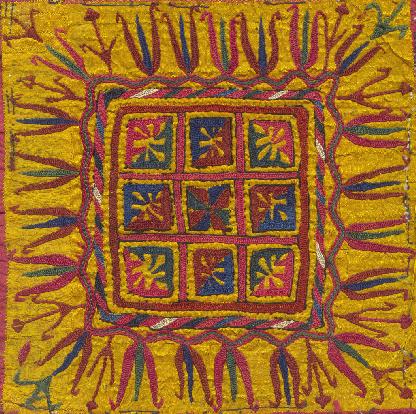
Regards,
Filiberto
Posted by Steve Price on 03-28-2002 06:27 AM:
Turkmen Mirror Bags
Hi People,
The Turkmen word for mirror is aina, and a mirror bag is an aina
khalta. Tsareva's book on Central Asian rugs includes
one illustration captioned as an aina khalta, but the piece is clearly a spoon or spindle bag in the most common
design for that type.
I have a small (perhaps 8" x 5") landscape format Yomud bag with remnants of a fringe at the bottom,
in which the field motif is the aina gul. I wonder whether this might be a specimen of the elusive aina khalta.
The size seems about right and the field design name is suggestive. Anybody have any information about this?
Regards,
Steve Price
Steve -
In an email conversation yesterday, Peter Andrews pointed me to a catalog for an exhibition he and his wife Mugul
curated in England in several locations in 1971 and 1972. As it happens I have a copy of that catalog, entitled
"The Turcoman of Iran."
This exhibition and this catolog list a great many of the objects that the Turkmen nomads that Peter and his wife
did field work with used in their lives. Listed are parts of the tent, the tent's furnishings, clothing and jewelry.
There are some photos but none of either a chanteh or of a mirror bag and there is no mention of a chanteh in the
catalog listing. But on page 57 there is a desciption of a mirror bag.
Here it is:
MIRROR BAG (AYNA TORBA, AYNA BOGCE) ed. some consonants are marked in ways that I can't here
silk
Yomut: Jeperbay (ed., a Yomut subtribe)
35 x 35 cms (ed., there are about 2 1/2 cms per inch, so it's about 14 inches square)
Tartan centre with red, green and purple borders. Machine stitching.
The bag is hung with its open side upper-most, like an envelope, from the lattice wall top.
Embroidered design: Goc in pairs (ed. again the "c" is marked, and this term appears to refer to a "horned
design")
Regards,
R. John Howe
Hi John,
The Turkish letter that looks like a C with a squiggle beneath it is pronounced "ch" (as in chicken)
in English; the one that looks like an S with a squiggle beneath is pronounced "sh". The word, bogce in Peter
Andrews' report that a mirror bag is an ayna bogce is more often written in English as bokche, which looks more like the way it is pronounced.
The goc
decoration he describes is probably the one more commonly represented in the rug literature as kochak.
Anyway, it is quite clear that the mirror bags he's seen in use are not at all like my little Yomud bag. The major
motifs are different, mine is pile while the pair he describes are embroidered, the sizes are quite different,
and the formats are different. It seems unlikely that my little bag was a mirror bag.
The machine stitching on the ones Peter describes is surprising to me. It isn't surprising that they are 20th century
pieces, of course, since he saw them in use in the second half of the 20th century. And anything made in the mid-20th
century was made well after the invention of the sewing machine. What's surprising is that pastoral nomads living
in tents had sewing machines. Perhaps their machines were little hand-held versions. A full size sewing machine
of that time was a bulky, clumsy, very heavy item; not the sort of thing I'd expect a nomad to haul around.
Regards,
Steve Price
Steve, I am not surprised to find sewing machines in the hands
of pastoral nomads. You find these just about anyplace; for example, at the weekly market in Saquisili (Ecuador)
the Quechua Indians bring their sewing machines and set them up on the fairgrounds (I know, these are not strictly
speaking pastoral nomads, but neither are they urbanized populations).
After all, pastoral nomads are not people who roam around at random - they generally move twice a year between
two fixed locations. In many places they nowadays use trucks, and, at least in Turkmenistan, they don't have to
clamber over high mountain passes.
Regards, Yon
Hi Yon,
I'm sure you're right about the trucks replacing the camels, and that makes the sewing machine just as portable
as a bunch of bags full of stuff. I saw some Yuruk encampments in Turkey two years ago, and they had trucks and
what appeared to be pretty high tech fabrics (metallic reflective material) for their tents.
Regards,
Steve Price
Hi all,
Well, Empress is my personal favorite. I like the paint job.
http://www.dincum.com/articles/articleimages/empindia1_res.jpg
Stuff like this is made in India and Pakistan and Empress (and others) is available on the market here. The Bedu
use it. I'd say it's about 14 pounds. It doesn't look like the design has changed since the Victorian days.
Regards.. Chuck
__________________
Chuck Wagner
Dear folks -
I've said this before but I have a an embroidered face said to be of a Tekke bokche. It's center is wonderful old
embroidery but that is sewn into first an area of wine red silk and then outside that some dark green. These outer
areas of stitching are by machine and offend me so that I think the piece is constructed with the center only from
an old chirpy perhaps and that may still be BUT
since the inventor of the sewing machine has my last name, I looked it up and he invented it in 1840 or thereabout
and began collecting royalties from Singer (nearly everyone here and in GB tried to steal his invention from him)
by the 1860s. So it is possible that small sewing machines of the type Chuck shows were into Central Asia in the
fourth quarter of the 19th century and perhaps slightly before that.
So these machine stitches are mostly just offensive rather than something that let's us say a piece was likely
made in the 20th century.
Regards,
R. John Howe
John,
Are you sure these stitches that offend you so are done with a machine ? I have a Turkmen embroidery that is definitely
done by hand, but that is so well done that it looks like machine work. I had to look under the backing to convince
myself, but sho' nuff, it's hand work.
Chuck
__________________
Chuck Wagner
Hi Chuck -
The unsightliness of these stitches is the main objection I have to them. They are all (about seven rows of them)
done on the dark green outer area. Mostly in white (just to make sure they aren't unobtrusive :-) ) but also two
rows of pink.
The stitches are very fine and very regular and a couple of rows suggest that the maker might even have had some
kind of zig-zag stitch attachment. I think they have clearly been done by machine.
The dealer who sold me this "bag face" insists that it is not a constructed item in the sense that a
part of an old chyrpy was taken as the center and then the wine and green areas added around it to bring it to
bokche size. He claims that the Tekke often made Bokches in just this way originally.
The difference in quality in the embroidery versus the outside machine stitched additions makes this seem less
likely to my inexperienced mind, but no matter about that. It is the ugliness of the stitches themselves that I
find objectionable and that have made me tempted to remove the red and green areas and to remount the center of
this piece.
I am very glad to have the center embroidered area, even if it is only a chyrpy fragment, because it is wonderful.
I'll try to get a direct scan or two insterted here.
Regards,
R. John Howe
OK John,
Finally Iím able to open the discussion board:
Here are your photos:



Regards,
Filiberto
Hi John,
I guess I'm so used to seeing pieced-together Turkoman goods that the stitching doesn't bother me much, but I do
agree that the white certainly stands out. One can only speculate on the circumstances surrounding this piece:
The results of picking around the Turkoman equivalent of a Goodwill bin ? Grandma clinging to a memory of her younger
days (older women wear white chyrpys)? Pakistanis cobbling stuff together acquired from Afghan refugees ? Who knows.
Nice embroidery work, though.
Since we're on the topic I'll try to get a couple scans made of the piece I mentioned earlier and send them to
Steviberto. I'll put another mirror bag in as well; it has some interesting knitted mesh around its periphery,
which is a little unusual.
As for the hand/machine question, I'll suggest the following: I think all machines use both a spool (above) and
a bobbin (beneath) to feed thread to the stitch. Thus a machine stitch should ALWAYS have thread on BOTH sides
of the piece. A hand stitch could pass over/under without doubling, but if it is doubled you should be able to
see the locking crossover somewhere. And, I thinks it's possible that a bobbin thread could be of a different gauge
that the spool thread. You may be able to tell from these indicators.
Either that or I'm wrong.
Regards.. Chuck
__________________
Chuck Wagner
A Turkmen Shoulder Thingy
Hi John (part B),
Here are some images of the embroidered article I mentioned, made to slip over the head of a child and sit on the
shoulders in a fashion similar to football shoulder pads. The digital camera is currently a non-participant, so
these are scans. The whole thing didn't quite fit; when the camera's in a better mood I'll try to get a shot of
the whole thing if you're sufficiently interested.
The maker clearly had a sewing machine: the backing is machine stitched to the front top cloth. But the embroidery
all appears to be hand work. The "chain-stitch strip" work is a bit of a puzzle; I suppose it's possible
that it's machine made and then tacked to the piece. But if so it's not easy to spot. There are no cut ends on
the short bits, and some of the terminations occur as single shots of silk floss rather than a tucked or folded
end.
Janet Harvey's book on Central Asian textiles has lots of photos showing this type of stitch, but no mention in
the text of machine involvement.
My wife says it's more likely knitted by hand and tacked, or possibly stitched in place. I'm pretty ignorant of
the whole stitching thing, so I'll go with her explanation. Either way, it's quite a piece of work.
The big picture, such as it is:

Front and back detail views of one of the swirls, clearly hand work:
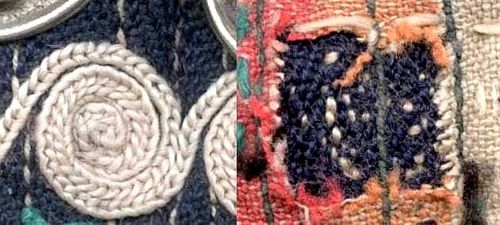
A close up:
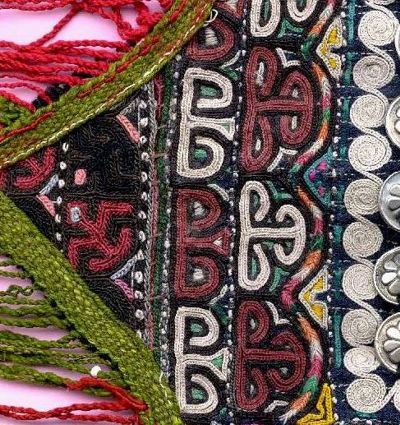
And a closer up:
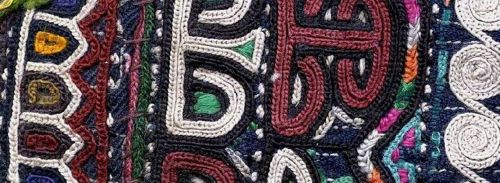
Regards.. Chuck
__________________
Chuck Wagner
Chuck, would you please post the dimensions of your piece, and
in particular the size of the opening in the middle?
Regards, Yon
Hi Yon,
The piece is 19" across. Side-to-side width of the hole in the center is 7 1/4", but less front-to-back.
It looks like it will accomodate an object about 5 1/2" across without stretching the stitches. The distance
across the lower horizontal row of white spirals in the first photo is 5 1/8". The distance left-to-right
across the last image is 3 1/4". The width of a chain stitch band is about 1/20th of an inch.

The other Uzbek mirror bag images will be posted shortly.
Or sooner:
Dimensions of bag body: : 13"H x 12"W
A classic Uzbek motif:

With a knitted band around the periphery:
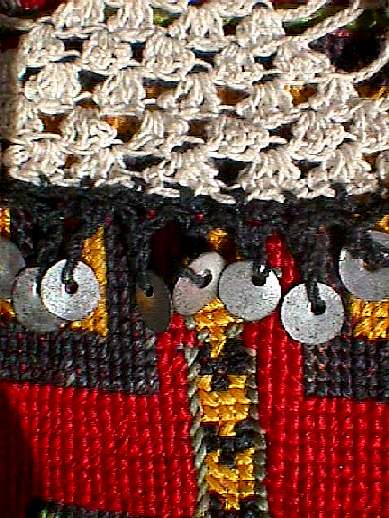
Regards, Chuck
__________________
Chuck Wagner
Hi all,
And to round things out, a Saudi flatweave handbag, about 30 to 40 years old:
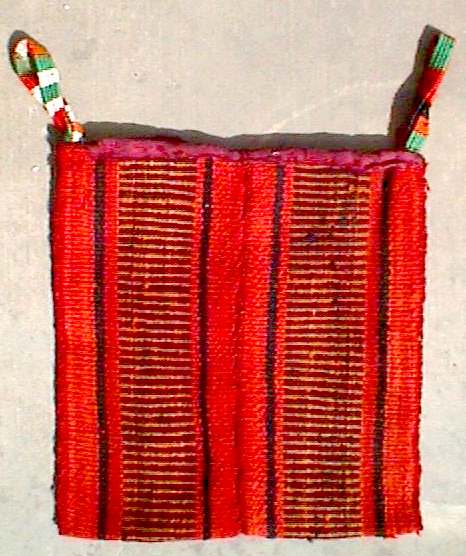
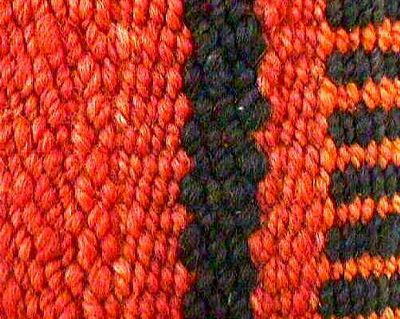
10" wide by 12" tall, gaudy leaky dyes, interesting weave. Two narrow strips stitched together, spiral
wrapped binding along the edges.
I'll also add an apology for the quality of the last few images. I think I did mention earlier that the camera
had become an unwilling participant in the project...
...Chuck
__________________
Chuck Wagner
All times are GMT -5 hours. The time now is 08:47 AM.
Powered by: vBulletin Version 2.2.1
Copyright © Jelsoft Enterprises Limited 2000, 2001.